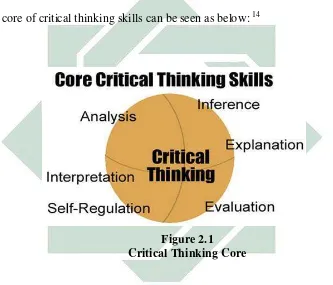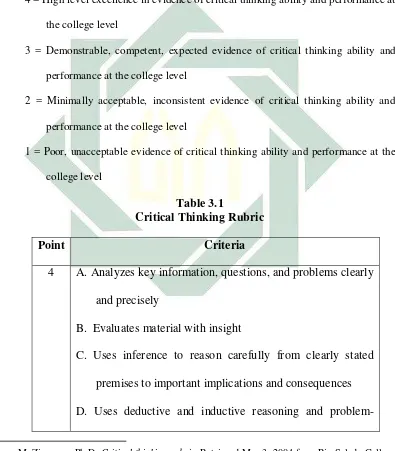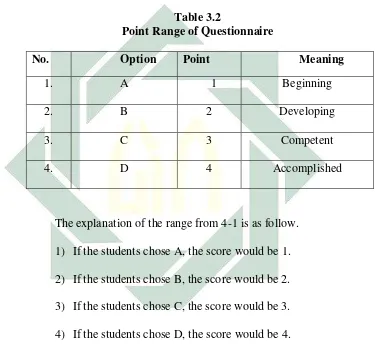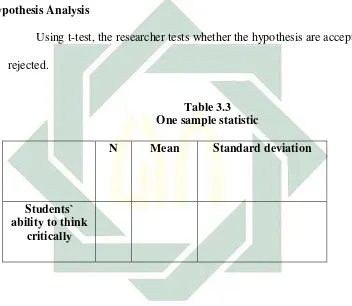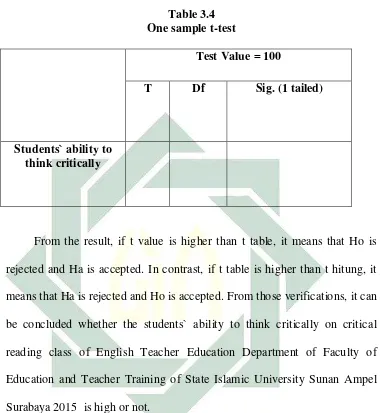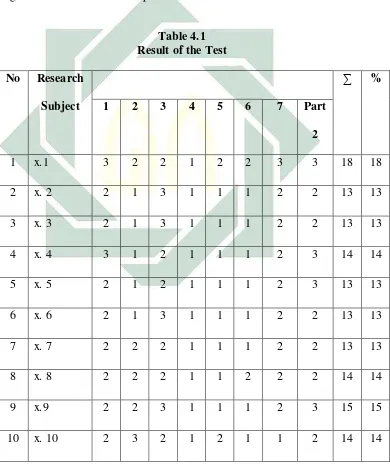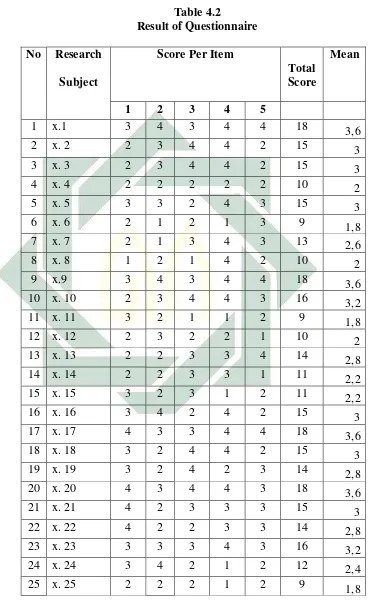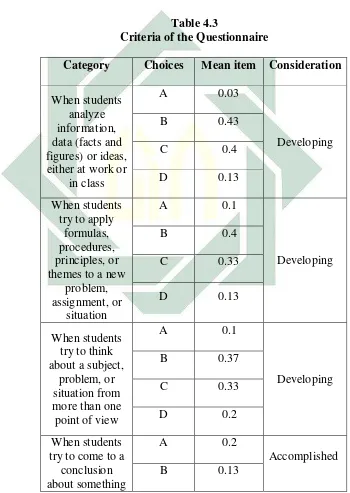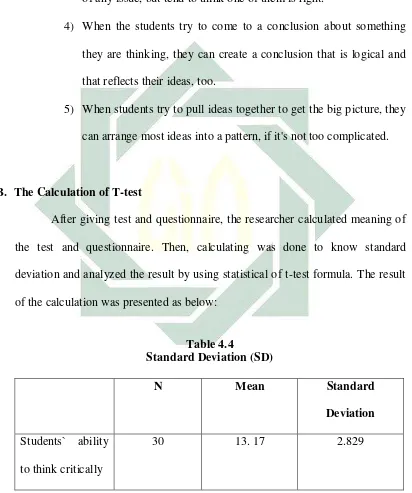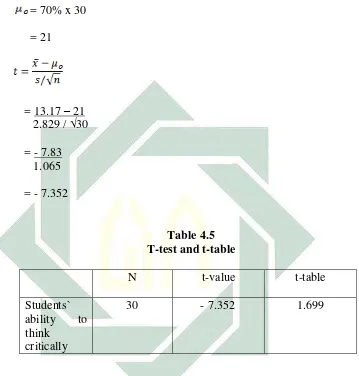THE STUDENTS` ABILITY TO THINK CRITICALLY
IN CRITICAL READING CLASS
AT ENGLISH TEACHER EDUCATION DEPARTMENT
OF FACULTY OF EDUCATION AND TEACHER
TRAINING OF STATE ISLAMIC UNIVERSITY
OF SUNAN AMPEL SURABAYA 2015
THESIS
Submitted in Partial Fulfillment of the Requirement for the Degree of
Sarjana Pendidikan (S.Pd) in Teaching English
By:
Istiharoh
NIM D05211033
ENGLISH TEACHER EDUCATION DEPARTMENT
FACULTY OF EDUCATION AND TEACHER TRAINING
STATE ISLAMIC UNIVERSITY
SUNAN AMPEL
ABSTRACT
Istiharoh. 2015. The Students` Ability to Think Critically on Critical Reading Class At English Teacher Education Department Of Faculty Of Education And Teacher Training Of State Islamic University Sunan Ampel Surabaya 2015. A thesis English Education Department, Faculty of Education and Teacher Training, State Islamic University (UIN) Sunan Ampel. Advisor I: Dra. Hj. Arbaiyah YS., MA. Advisor II: Ana Nurul Laila M.TESOL
Key Word: Ability, Critical Thinking
Critical thinking gives much contribution to the successful of someone`s reading process. Having high critical thinking ability will make the learners be creative and active. The students will never know their ability to think critically without measuring it. The English learners can measure their ability to think critically through reading. Since reading is a part of important ways to acquiring knowledge, it is important to gain critical thinking ability of the university students and its possible link to their reading. Related to this, the researcher conducts a research on the students` ability to think critically. The objectives of this study are to know the students` ability to think critically in critical reading class.
Quantitative approach is carried in descriptive design to find the objective above. The sample is all population which consists of 30 students. In process collecting data, first the researcher gives a critical thinking test to the students to know the students` ability to think critically from external perspective. Then, the researcher asks the students to fill in the questionnaire to know their ability to think critically from internal perspective. The questionnaire is a reflective after doing the critical thinking test given and self assess for the students.
Based on the result of the study, it can be seen that t-table (1,699) is higher than t-value (- 7,352) which means that Ha rejected and Ho accepted. It means that less than 70% students on critical reading class of English Teacher Education Department of Faculty Of Education And Teacher Training Of State Islamic University Sunan Ampel Surabaya have high ability to think critically.
The average of the students` score of critical thinking test is 13,17 in which the highest level is 32. It means that the students` ability is low because it is under 50% of the highest level of score. It can be said that students’ ability to think critically from external perspective is low.
LIST OF CONTENT
The Inside Cover... i
Approval sheet ... ii
Examiners` Approval Sheet... iii
Declaration ... iv
Dedication ... v
Acknowledgement ... vi
Motto ... vii
Abstract ... viii
List of Content ... ix
List of Table ... xi
List of Figure ... xii
List of Appendix ... xiii
CHAPTER I: INTRODUCTION ... 1
A. Background of the Study ... 1
B. Statement of Problem ... 5
C. Objective of the Study ... 5
D. Significance of the Study ... 6
E. Scope and Limitation of the Study ... 6
F. Definition of Key Term ... 7
G. Research Report Writing Organization ... 8
CHAPTER II: REVIEW OF RELATED LITERATURE ... 9
A. Critical Thinking: Features of Critical Thinking ... 9
B. Critical Thinking Tools ... 13
C. Impotance of Critical Thinking in Education ... 18
D. Ability to Think Critically ... 19
CHAPTER IV: RESEARCH FINDING AND DISCUSSION ... 39
A. Research Finding ... 39
1. The Students` ability to think critically from external Perspective ... 39
2. The Students` Level of Critical Thinking Ability from external perspective ... 43
a. Tabulating data of the questionnaire ... 45
b. Concluding the questionnaire result ... 48
B. The Calculation of T-test ... 49
C. Hypothesis Testing ... 52
D. Discussion ... 52
CHAPTER V: CONCLUSION AND SUGGESTION ... 58
A. Conclusion ... 58
B. Suggestion ... 60
BIBLIOGRAPHY
CHAPTER I
INTRODUCTION
This chapter provides the background of the study, the research problems, the objectives of the research, significance of the study to let the reader recognize about the value of the result of study, scope and limitation of the research and definition of key terms.
A. Background of Study
In this era, university students are expected to be able to think critically. Critical thinking is important to gain the information which was gotten, to have better chances and to life with the society. It is like Robinson`s opinion, if students are to perform in a highly technical society, they must be prepared with life-long learning and critical thinking skills is necessary to obtain and process information in an ever-changing world.1 When someone thought about something which wants to be done, the person needs to decide whether the thing is appropriate or not. To do this well, the person had to have a good ability in critical thinking.
Critical thinking plays an important role in language education. Wallace stated that critical thinking skills should be embedded in the subject matter and
1
Figen Kanik. Doctoral Dissertation. An Assessment Of Teachers’ Conceptions Of Critical Thinking
2
woven into language education.2
Since language is an important tool for acquiring knowledge, therefore it is important to acquire on the way into the nature of the critical thinking ability of the students and its possible link to their language proficiency.
The English learners can measure their ability to think critically through reading, especially in understanding the texts which are read. When they reading a text, they can think about the concept, see the value from many points of view, able to make a logical conclusion, and link their ideas with the text they read. By doing these activities, the students are able to measure their ability to think critically through reading. As Nodoushan statement that measuring students` ability to think critically using a test of reading could be justified on the following part. Firsts, many of the critical thinking tests through reading texts with questions related to interpretation, inference, analysis, and evaluation. Second, there were high correlations between tests of critical thinking skills and the reading text. It was showed by studies in both United States and the Middle East.3 Critical thinking gives much contribution to the successful of someone`s reading, especially in reading class. In thinking process, this is proposed to engage students when talking about text they read. This activity leads the students to be critical. By having this ability, the students will able to answer the questions
2
C. Wallace. Critical reading in language education. (Palgrave Macmillan. 2005) accessed on 15th June 2015
3
3
of reading test, give evidences, facts, or proof to make a convince answer and elaborate information of the text with their own ideas.
In education department, especially in English Teacher Education Department of Faculty of Education and Teacher Training of State Islamic University Sunan Ampel Surabaya, have high critical thinking is important for candidates of the teacher to be a creative, professional and active teacher. Without having this ability the students will not be able to show their view and their well-constructed argument. As Judge, Jones and McCreery say that If the students are able to confront others’ ideas in this way it enables the students to construct their
own judgments, which in turn enhances their self-confidence in exploring any
evidence or literature and its implications.4
Critical thinking is also important for shaping creative candidates of English teachers. The students need to think critically to come up with creative solution to a problem. It must also be the circumstance that the new ideas being produced are useful and relevant to the task at hand. Critical thinking plays a central role in evaluating new ideas, selecting the best and adapting them if necessary.
Regardless the major, in fact, critical thinking plays an important role in shaping the students` creativity. In this case, the candidates of English Teacher in State Islamic University of Sunan Ampel Surabaya must have ability to think critically. It cannot be imagined that a candidate of teacher are unable think
4
4
critically. It means that the candidate is unable to construct the argument well, to create creative teaching instruments, and to teach the students well. Critical thinking improves language, writing and presentation skills. Thinking clearly and systematically can enhance the way expressing ideas. In learning how to analyze the logical structure of writings, critical thinking also enhances comprehension abilities. Without knowing the ability to think critically, the candidates of teacher will never know whether they are able to construct the argument well or not.
In order to live a meaningful life and to structure our lives, justify and reflect on our values and decisions are needed. The tools for this process of self-evaluation are provided by critical thinking. By having this ability, the people are able to choose the best step or way for their future life, to reflect their life in the past and to make their life better in the future by learning from their experience in the past.
Arguments which are explored do not usually mean disagree with something; it simply means presenting a strong case to support a point of view. The speaker should not be an argumentative person to do this. On the other side, good critical thinking means using reason and evidence to support the point. 5
In developed countries, various studies have been conducted to reveal teachers’ conceptions of critical thinking, the degree to which teachers are
actively involved in improving their students’ critical thinking and the factors that
5
5
foster and inhibit teachers’ efforts to teach for critical thinking. But, there are still many questions about critical thinking especially in education which are not answered yet.
In conclusion, since reading is a part of important ways to acquiring knowledge, it is important to gain critical thinking ability of the university students and its possible link to their reading. The researcher is interested to conduct the research entitled “The Students` Ability to Think Critically in Critical Reading Class of English Teacher Education Department of Faculty of Education and Teacher Training of State Islamic University Sunan Ampel Surabaya 2015.”
B. Research Question
Based on the background of study above, the statements of the problem for the current study is “what is the students` ability to think critically in critical reading class of English Teacher Education Department of Faculty of Education and Teacher Training of State Islamic University Sunan Ampel Surabaya 2015 ?.”
C. Objective of Study
6
D. Significant of Study
This research is conducted to find out the students` ability to think critically in critical reading class at English Teacher Education Department of Faculty of Education and Teacher Training of State Islamic University Sunan Ampel Surabaya 2015. Researcher expects this research will give some benefits, at least such below:
1. Lecturers
a. The lecturer can increase the students’ ability in critical thinking and give them some more exercises to improve their ability in it.
b. The result of this research can be used by the lecturers for looking for the best way to teach critical thinking.
2. The students can measure their ability in critical thinking whether their ability is high, fair or low.
E. Scope and Limitation
Critical thinking is used in many ways in this word. However, this research focuses on students` ability to think critically in reading class. Scope and limitation will be explained below:
7
2. It is limited to the students of critical reading class at Faculty of Education and Teacher Training of State Islamic University Sunan Ampel Surabaya year 2015.
F. Definition of Key Terms
1. Ability
Thurstone saying which was quoted by Tapsfield in his book defined ability is best understood.6 Tucker stated that the word ability refers to the capabilities of human nature. It can either be moral or immoral abilities. The ability to perform immorally derives from the physical abilities, but the decision to do so clearly issues from minds.7
In this research, the term `ability` means that maximal performance of someone when think critically on reading class.
2. Critical thinking
Brenda says that critical thinking is” the ability to think about your own thinking in such a way as to recognize its strengths and weaknesses and, as a result, and re-present the thinking in an improved form.”8
In this research, critical thinking is defined as a way to recognize and re-present the thinking in an improved form.
6
Ian Dennis - Patrick Tapsfield (Ed.) Human Abilities, Their Nature an Measurement.(United States of America: Lawrence Erlbaum Associates. 1996), 200.
7
John Allen Tucker. Itō Jinsai's Gomō Jigi and the Philosophical Definition of Early Modern Japan. (Brill, 1998), 153.
8
8
G. Research Report Writing Organization
The organization of a research paper is provided in order to make readers understand the content of the paper as follows.
The first is the introduction. It consists of the background of the study, statement of the problems, objectives of the study, significance of the study, scope and limitation, definition of key terms, and research report writing organization.
The second is review of related literature. It consists of previous study and underlying theory. The underlying theory consists of critical thinking, critical thinking tools, importance critical thinking in education, ability to think critically and some previous studies.
The third is the research method. It consists of type of research design, hypothesis, population and sample, setting and subject of the study, research procedure, data and source of data, data collection technique, research instrument and data analysis technique.
The forth is research finding and discussion. It consists of some data analysis from test which is given by the researcher and other data gotten from questionnaire.
CHAPTER II
REVIEW OF RELATED LITERATURE
In a research, it is important to describe the theories related to the problems of this study, which are used as foundation and reference in order to give relevant knowledge in the field.
A. Critical Thinking
Dewey introduced more recent effects in the critical thinking show ground. Dewey named critical thinking “reflective thinking” and described it as “an
active, persistent, and careful consideration of a belief or supposed form of knowledge in the light of the grounds which support it and the further conclusions to which it tends” .9
Alfaro-LeFevre saying which was quoted by Shelley Cohen in his book defined “critical thinking as careful, deliberate, outcome-focused (results oriented) thinking that is mastered for a context.”10
This opinion is also supported by Stella Cotrell. In her book, Stella Cotrell also defined Critical thinking as thinking activity which purposed to give reasons and reflection which focus on what are believed and will be done.11
9
John Dewey. How We Think. (Lexington, Mass: D.C. Heath, 1910), 2.
10
As quoted in Shelley Cohen. Critical Thinking in the Emergency Department: Skills to Assess, Analyze, and Act. (HCPro, Inc. 2006), 3.
11
10
Galotti also gave definition of critical thinking that is: "Mental activity that consists of transforming given information (called a set of premises) in order to reach conclusions".12 This definition describes that critical thinking is activities of thinking which have purpose to give conclusion or decision about something.
Based on those definitions of critical thinking, can be concluded that critical thinking is an activity that focus on thinking actively, creatively and carefully based on what have been understood and believed.
Critical thinking should not be complicated with being argumentative or being analytical of other people. Critical thinking can also play an important role in collaborative reasoning and constructive tasks, although critical thinking skills can be used in showing misconceptions and bad reasoning. Critical thinking can be used to help to acquire knowledge, improve theories, and strengthen arguments. Using critical thinking can be done to enhance work processes and improve social institutions.
1. Features of Critical Thinking
According to Jim Wohlpart, the features of critical thinking are:13 a. Overview of an Argument:
1) Consciousness of Point of View
2) Consciousness of Intention and Audience 3) Statement of Central Problem or Issue
12 Kathleen M. Galotti . “Approaches to studying formal and everyday reasoning”. Psychological Bulletin, Vol. 105, No. 3, 1989, 331.
11
4) Understanding Key Ideas b. Internal Elements of an Argument
1) Deduction: Consciousness of Inferences and Assumptions 2) Induction: Analysis of Information and Proof
According to Murti, critical thinking have some parts or features. The core of critical thinking skills can be seen as below: 14
Figure 2.1 Critical Thinking Core
When answering the questions, the students need to put some reasons or arguments which can hold their answer. Argument means fully grown reasoning.By fully grown, means that an attitude and approach to argument, not an age group. And all of us, irrespective of age, sometimes fall in fully grown reasoning.What is "fully grown" about the kind of argument we have
14
12
in mind? One meaning of fully grown is "worked out completely by the mind" or " considered".15 The second term in this delineation of argument also needs remark: reasoning. If we study logic deeply, we find many delineations of reasoning, but for applied purposes,reasoning here means an opinion and more a reason (or reasons) for holding that answer or opinion. 16
When you feel confident having the opinion to answer the questions figured out, you are ready to respond to it, which means appraising and comparing it with other perspective, involving your own. For doing those, annotate deeply is the key.
When thinking critically in reading process, there are two common problems which may come up:
a. Ambiguity
According to Brenda et al, ambiguity is a word that has several different meaning.17 For instance, “partnership” might particularly refer to a legally edging collaboration between two or more people. More commonly, it may mean co-operation between interested investors in a specific project. In education it can be translated as concerning parents as co-educators of their children. In a broader sense it can be comprehended as a partnership between stakeholders in the education
15Timothy W. Crusius and Carolyn E. Channell. The Aims of Argument: a brief guide. (McGraw-Hill.
New York, 2006), 3.
16 Timothy W. Crusius and Carolyn E. Channell. 2006. The Aims of Argument: a brief guide. . (McGraw-Hill. New York, 2006), 4.
17
13
system, such as national government, local government and perhaps even business.
b. Subjectivity
Subjectivity is the readers are still disagreeing about the meaning even the ambiguity was removed from the paragraph. For example, it is about a very subjective one. Two people may agree accurately about what that partnership is (e.g. they may agree that it is conversation between teachers and parents), but disagree about the deepness of participation both parties should have.
B. Critical Thinking Tools
The following critical thinking tools terms and elements of argument are used throughout evaluate critical thinking; to explore the ideas, arguments, and conclusions; and to analyze the arguments and writing decisions of other writers.18
1. Purpose of Reading.
When starting to read, purpose that is the points should be clear and consistent from the beginning to the end of text, an essay or paragraph. Everything which included should advance that purpose.
When reading, ask these questions for reflection:
18
14
What is the author’s purpose for writing?
What arguments is the author putting forth?
What direct or implied questions is he or she addressing?
2. Ideas and Information to Support the Answer of Questions Based on The Text.
When answering the question after reading the text, develop the answer using the personal ideas, personal knowledge, and information. The ideas and background information are specific branches of the tree that forms the purpose expanded upon it.Next, develop these personal ideas, or branches, using examples, ideas, facts, and commentary.
When reading,ask these questions for reflection:
What ideas does the author include to support the purpose? What background information does the author provide? Purpose
Ideas
3. Providing Supporting Details.
15
provided by other writers. Include commentary about the examples and details provided.
When reading, ask these questions for reflection:
What evidence or examples which the author using to support reasoning?
Are the examples and support believable and clearly explained? Do they adequately support the author’s purpose?
4. Make Sure Are There Any Assumptions and Biases Made by The Author.
Make sure that the assumptions which the author makes about a topic or idea are not flawed or based on misinformation. Check for any errors in ideas resulting from an unfounded favoritism in thinking process or that of an author. Any mistakes in the concepts or ideas that the reasoning is based on can cause problems in the argument. So, although assumptions and biases are supportive tools, they can throw a wrench in the thinking if they are unfounded.
When you read, ask these questions for reflection:
Are there errors in the ideas the author is explaining?
16
5. Understand The Conclusions, Implications, and Consequences of The Text.
A conclusion is the final point in the argument, the place reached after discussing the ideas that support the purpose, the argument. Consequences are the results of a point that have been argued. Implications are more subtle: They are the possible results of an argument that have been inferred (or an author has implied). Make sure to look at all the possible consequences of the argument. For instance, if arguing that the music program should be cancelled at the school and the money should be used to add more parking spaces at the campus, Make sure to address all the implications and consequences of canceling the music program. Be aware that implying that having more parking spaces is more important to the school than having a music program is needed. The consequences could be a loss in the artistic identity of the school, fewer students who wanted to focus on music would apply to the college, and so on.
When reading, ask these questions for reflection:
What are the implications of the author’s ideas in this reading?
17
dominoes that follow that one. They might not be directly stated in the paper: those last dominoes falling and what they mean are needed to be imagined. For instance, will the stopping of the music program lead to a decrease in registration and hurt the overall budget at the school and the quality of the education provided?
6. Understand The Point of View.
Point of view is perspective on a topic. Make sure to check the assumptions of point of view is based upon and whether the point of view is unreasonably biased.
When reading,ask these questions for reflection:
What point of view does the author have on the topic?
Did the author consider other points of view that might be relevant?
Is the point of view one-sided or biased? 7. Analysis the Text.
Analysis includes breaking down an idea and working out the meaning of the separate parts and how they relate to the whole. It is a depth look at every detail of an idea or argument, like using an expanding glass to examine something up near and carefully.
When reading, ask these questions for reflection:
18
Does the author develop the ideas well using specific ideas, support, and analysis?
C. Importance of Critical Thinking in Education
Since human are created to be social creature, critical thinking is important for every human around the world especially in education. As a teacher or student, she/he should recognize the way how to construct argument. As Lipman argue, two important qualities of critical thinking skills are greatly improved reading comprehension and the ability to communicate the in-depth awareness obtained from increased understanding.19
Brenda et al say that critical and analytical thinking skills will be essential to most aspects of the students` study, whether the students are listening to lectures, contributing to seminars or reading about the students` subject.20 As education student, regardless the major, the most important skills that the students will need to learn is ability to think critically and objectively about an issue and present a well-constructed argument.
The purposes of education is to create students who are well informed, first, students should understand ideas that are important, useful, beautiful, and powerful. Second, to create students who have the passion to think analytically
19
Matthew Lipman. Thinking in Education. (Cambridge: Cambridge University Press. 2003), 17.
20
19
and critically, to use what the students know to improve their own lives and also to contribute to their society, culture, and civilization.
D. Ability to Think Critically
A critical thinker is someone who able to do these following things:21 1. Understand the logical relationships between opinions
2. Formulate ideas briefly and accurately 3. Identify, construct, and evaluate argument 4. Evaluate pros and cons of strength of will
5. Evaluate the evidence for and against a hypothesis 6. Detect discrepancies and familiar mistakes in reasoning 7. Analyze the problem methodically
8. Identify the relevance and significance of ideas 9. Justify one`s beliefs and standards
10.Consider and evaluate one`s thinking skills.
The habitual of an ideal critical thinker is inquisitorial, well-informed, trustful of reason, open-minded, flexible, fair minded in evaluation, honest in facing personal favoritisms, careful in making judgments, willing to reconsider, clear about issues, orderly in complex matters, diligent in seeking relevant information, reasonable in the selection of criteria, focused in inquiry, and
21
20
persistent in seeking results which are as accurate as the subject and the conditions of investigation permit. Therefore, educating good critical thinkers means working toward this model. It combines developing critical thinking skills with encouraging those dispositions which consistently produce useful perceptions and which are the basis of a rational and democratic society.22
Critical thinking is a fundamental ability of thinking and essential in academic studies. The critical thinker tries to appraise what information had read, heard and seen. The foundations conclusions on rational thinking and the knowledge associated with the theme. Critical thinking ability can be enhanced. The ability of critical thinking is closely associated with the knowledge of the scientific subject in question, and that is why very specific instructions cannot be given.23
Critical thinking skill is an important skill in reading. To promote academic success, critical thinking skills are also important if students become critical consumers and producers of information in a democratic society.24
The relationship between critical thinking and reading is well recognized in the writing. For instance, Norris and Phillips point out that reading is more than
22
Dr. Peter A. Facione. A report for the American Philosophical Association "Critical Thinking: A Statement of Expert Consensus for Purposes of Educational Assessment and Instruction", (California: California Academic Press. 1990), 2.
23 “
Critical Thinking And Career Education: Situation Analysis And Assessment Questionnaire”. 94313-CP-1-1-LT-COMENIUS-C2.1, Finland. 2001, 1-2.
24
21
just stating what is on the page; it is thinking.25 Anderson says that there are six ways in thinking and in remembering text information. They are:26
1. Most new knowledge is obtained by integrating new information into existing structure.
2. The students’ existing schemata facilitate to allocate attention by focusing on what is relevant and significant in newly presented materials.
3. Schemata allow and direct the inferential amplification of inward information and experience.
4. Schemata permit organized searches of memory by providing students with a guide to the types of information that should be remembered.
5. Schemata help learners in thinking skills of summarizing and editing.
6. Schemata allow inferential reconstruction when there are spaces in memory, which means that they help the learner make hypotheses about missing information.
Thinking process and reading may are taught in one subject in a college. It
is called as critical reading. Jennifer Duncan defined Critical reading as a “process of analyzing, interpreting and, sometimes, evaluating.”27When the
students read critically, they use their critical thinking ability to questionboth the
25
Norris, Stephen P., Phillips, and Linda M, “Explanations of reading comprehension: schema theory and critical thinking theory”. Teachers College Record. v89 n2 Win 1987, 281.
26
Richard C. Anderson, Role of the reader’s schema in comprehension, learning, and memory. (In: Ruddell, R.B., Ruddell, M.R., Singer, H. (Eds.), Theoretical Models and Processes of Reading, fourth ed. International Reading Association, Newark,1994), 271.
27
22
text and their own reading of it. For doing reading critically, think critically must be done. The critical thinking activities involve analysis, interpretation, and evaluation. Jennifer Duncan said that each of these processes helps the students to relate with the text in different ways: stressing important points and examples, taking notes, testing the answers to the students` questions, brainstorming, outlining, describing features of the text or argument, reflecting on their own reading and thinking, raising protests to the ideas or evidence presented, etc.28
For a critical reader, any single text provides but one representation of the facts, one individual’s take on the subject matter. Critical readers recognize not
only what a text says, but also how that text representation the subject matter. Critical readers recognize that a variety of ways in which each and every text is the unique formation of a unique author.29
Critical reading has two steps further. After recognizing what a textsays, it is a sign of on what the text does by making such remarks. Is the text offering examples? Is the text offering Argument? Is the text offer appealing for sympathy? Making a contrast to clarify a point? Finally, critical readers then infer what the text, as a whole, means, based on the earlier analysis. 30
28
Jennifer Duncan. Reading Critically. The Writing Centre, University of Toronto Scarborough. (http://ctl.utsc.utoronto.ca/twc/webresources accessed on 15th June 2015).
29
Daniel J. Kurland. How the Language Really Works:
(www.criticalthinking.com accessed on 17th June 2015).
30
23
These are three steps or modes of analysis which are reflected in three types of reading and discussion: 31
1. What a text discuss – restatement 2. What a text does – description 3. What a text means – interpretation.
There are some certain goals that need to accomplish by the students for textbooks on critical reading: 32
1. For recognizing an author’s purpose 2. For understanding tone and persuasive elements 3. For recognizing bias
E. Review of Previous Studies
In a research, it is essential to find review of previous studies to avoid the repetition. Some similar studies had been conducted about critical thinking. The previous study was done by Genal Hove entitled Developing Critical Thinking Skills in the High School English Classroom. He tried to analyze current literature and examine strategies for developing critical thinking skills in high school-aged students.33
31
Daniel J. Kurland. How the Language……… accessed on 17th June 2015
32
Daniel J. Kurland. How the Language……… accessed on 17th June 2015
33
24
The second is “An Assessment of Teachers’ Conceptions of Critical
Thinking and Practices for Critical Thinking Development at Seventh Grade Level” which had been conducted by Figen Kanik. In her research, she tried to explore teachers’ conceptions of critical thinking and practices for critical
thinking development in Turkish, social studies, science and technology and
mathematics courses at seventh grade level.34
The third was done by Ririn Khoridah entitled Efektifitas Model Pembelajaran Critical Thinking Dalam Meningkatkan Pemahaman Siswa Pada Bidang Studi PAI Di SMP Unggulan Al-Falah Siwalanpanji Buduran Sidoarjo. In her research, she analyzed the implementation of critical thinking method in learning, the strategies that used to improve students` understanding, and the effectiveness of critical thinking method in improving students` understanding.35
The fourth is “Efektifitas Penerapan Model Pembelajaran Berbasis Deep
Dialogue/Critical Thinking (DD/CT) Terhadap Prestasi Belajar Siswa Kelas VIII B Pada Mata Pelajaran Pendidikan Agama Islam Di SMP Negeri 2 Tanggulangin Kabupaten Sidoarjo” which has been conducted by Niswatul Hasanah. She
34
Figen Kanik. Doctoral Dissertation. An Assessment Of Teachers’ Conceptions Of Critical Thinking And Practices For Critical Thinking Development At Seventh Grade Level. (Middle East Technical University. 2010), 10.
35
25
analyzed the implementation of Deep Dialogue/Critical Thinking Method and the effectiveness of the Method in students` achievement. 36
Considering those previous studies, this research will be different. The difference of those previous studies are that this research focused on students` ability to think critically in English Education Department and students` level of critical thinking ability, while the previous study focus on developing critical thinking in senior high school and an assessment of teachers’ conceptions of critical thinking and practices for critical thinking development at seven grade students. The text which is used for assessment in recent research is an article, while the previous research is a novel.
36
Niswatul Hasanah. Unpublished thesis. Efektifitas Penerapan Model Pembelajaran Berbasis Deep
CHAPTER III
RESEARCH METHOD
In this chapter, researcher described the research design which would be used in this study, hypothesis, population and sample, setting and subject of the study, data and source of data, data collection technique, research instrument, and data analysis technique. To make them clear, the researcher elaborated them one by one in the following part of this thesis.
A. Research Design
The methodology of this study was quantitative. Mertler stated that the
general purpose of quantitative research is to investigate a particular topic or activity through the measurement of variable in numerical data.37A major concept of pragmatism is that quantitative and qualitative methods are balance. It could help to get good answer for the statement of problem. In this research, descriptive quantitative was used.
In quantitative research, the data was gathered on an instrument that measures attitudes, and the information was examined using statistical procedures and hypothesis testing. 38The researcher collected the data using some
37
Craig A. Mertler, Introduction to educational research. (United States of America: SAGE Publications, 2014), 213.
38
John W Creswell. Research Design Qualitative, Quantitative, and Mixed Method Approach.
27
instruments and analyzed it statistically. It purposed to test whether the hypothesis is accepted or not.
B. Hypothesis
Ha : More than 70% students in critical reading class of English Teacher Education Department of Faculty of Education and Teacher Training of State Islamic University Sunan Ampel Surabaya have high ability to think critically.
Ho : Less than 70% students in critical reading class of English Teacher Education Department of Faculty of Education and Teacher Training of State Islamic University Sunan Ampel Surabaya have high ability to think critically.
Statistical Hypothesis: Ha : µ 0 > 70%
Ho : µ 0 < 70%
The creations are:
Ha accepted if t-value > t-table Ho accepted if t-value < t-table
C. Setting and Research Subject
28
reason that based on researcher study; critical reading class serves the students to learn how to think critically.
D. Population and Sample
Population means the entire subject which want to be researched drawn by the researcher. As Arikunto said that population is the whole subject of research.39 In this research, the population was all students of critical reading class at faculty of education and teacher training of state islamic university of sunan ampel surabaya 2015.
In this study, researcher did not have sample. All of the population is researched because the number of population was fewer than 100. It is based on Arikunto statement that for presupposition, if the subject was less than 100, it would be better to take all of the subjects. It was population research.40
E. Data Collection Procedure
This research was quantitative research. To obtain the data, the researcher conducted a written assessment for the students to do and distributed questionnaires. The procedure to collect the data as follow:
39
Suharsimi Ariikunto. Prosedur Penelitian Suatu Pendekatan Praktek, (Jakarta: Bina Aksara, 1987), 130
40
29
1. After reading the article given, the students were given questions to answer to look at their critical thinking ability. The test type is written test individually.
2. Then, the students are asked to fill in the questionnaire based on their experiences.
F. Data And Source Of Data
1. The data which are needed are:
a. The students` ability to think critically score.
b. The students` response to the self assess of ability to think critically. 2. Source of Data
The students of critical reading class of English Education Department. 3. Data collection Technique
Data collection was the process of gathering information in a disciplined and systematic way about the research problems.
The data that the researcher would get are from test questionnaire that would be given to the students of Critical Reading Class. The data would be taken from the data that the researcher got from test and questionnaire.
a. Assesment (test)
30
b. Questionnaire
Questionnaires were usually related with correlation field study (survey) projects, of which the mail (postal) questionnaire was the most popular.41 In this research, the students were given some questions about some problems that have purpose to get opinion of the students. The students must answer the question based on what they got. The question was to know the information about the students` ability to think critically from internal perspective.
G. Research Instrument
The researcher needed instruments in order to be easier to collect the data. 1. Assesment (test) sheet
This instrument was used to answer the research question “What is the students` ability to think critically on critical reading class of English Teacher Education Department of Faculty of Education and Teacher Training of State Islamic University Sunan Ampel Surabaya 2015.” It contained some questions to measure the students' ability to think critically whether their ability was high, fair or low from external perspective. The researcher conducted the test after giving the article.
41
31
2. Critical thinking rubric
This instrument was used for evaluating the students` answer of critical thinking test given. It was used to find out the students` ability to think critically score. The rubric was adapted from Critical thinking rubric.42
3. Questionnaires
To bring together data by means of questionnaire, the researcher must make some questions. This instrument was used to gather other information related to the students` ability to think critically from internal perspective. The researcher provided the questionnaire that consists of some questions related to it. This questionnaire was also used as self assessment for the students whether their critical thinking ability was on beginner, developing, competent, or accomplished.
H. Data Analysis Technique
1. Students` result of the test of critical thinking ability
The researcher conducted a think aloud in an effort to model and
reveal how they think critically about a passage from the text. As a whole
class group, the students were asked to practice to inference several passages
from the article.
42
Dawn M. Zimmaro, Ph.D. Critical thinking rubric. Retrieved May 3, 2004 from Rio Salado College
32
To know whether the students` answer was good or not, an analyzing to the answer should be done. There were three ways to analyze the students` answer of the critical thinking test: 43
a. Find the reason or reasons progressive to justify the demand. All statements of reason will answer the question, "why are you demanding what you've demanded?" They can connect to the demand with because. As with demands, reasons may be implied. Excavate them out and utter them in your own words.
b. Consider each reason progressive. Is the reason well-behaved in itself? Is the reason relevant to the thesis? Note any problems.
c. The researcher analyzed the students` answers on the reading quiz (Appendix A) based on expression of critical thinking. An answer
expressing critical thinking would be given 4 points. A
critically-thought out answer made inferences and assumptions about the text.
Basic answers were factual and grounded within the article only, with
little evidence of profound, personal reflection and thinking.
The researcher would find out the higher score, the lowest score, and
the average of the students` ability to think critically score. The
students` ability to think critically is high when they get 25 to 32
(maximum score). If they get 18 to 25 their ability to think critically
33
is fair and if they get score under 18 their ability to think critically is
low. Those score was based on critical thinking rubric below.
Critical Thinking Rubric44
4 = High level excellence in evidence of critical thinking ability and performance at
the college level
3 = Demonstrable, competent, expected evidence of critical thinking ability and
performance at the college level
2 = Minimally acceptable, inconsistent evidence of critical thinking ability and
performance at the college level
1 = Poor, unacceptable evidence of critical thinking ability and performance at the
college level
Table 3.1
Critical Thinking Rubric
Point Criteria
4 A. Analyzes key information, questions, and problems clearly and precisely
B. Evaluates material with insight
C. Uses inference to reason carefully from clearly stated premises to important implications and consequences D. Uses deductive and inductive reasoning and
44
Dawn M. Zimmaro, Ph.D. Critical thinking rubric. Retrieved May 3, 2004 from Rio Salado College
34
solving skills consistently and with ease
3 A. Analyzes key information, questions, and problems competently
B. Evaluates material competently
C. Uses inference to reason competently from clearly stated premises to important implications and consequences D. Uses deductive and inductive reasoning and
problem-solving skills competently
2 A. Analyzes some key information, questions, and problems competently
B. Evaluates material inconsistently
C. Uses inference to reason inconsistently from clearly stated premises to implications and consequences
D. Uses deductive and inductive reasoning and problem-solving skills inconsistently and weakly
1 A. Is unable to analyze information, questions, and problems or does so superficially
B. Is unable to evaluate material or does so superficially C. Is unable to or infrequently uses inference to reason from
35
D. Is unable to or infrequently uses deductive and inductive reasoning and problem-solving skills
To count the students’ average score, the procedure was formulated as follows:
Formula: Mean =
Note:
Mean = Students’ Average Score ∑FX = Total of Students’ Score
N = Number of Students
After knowing the average of the students` score, the researcher found the average percentage of the students` score, the following formula was used.
The average percentage of students` score = the total of percentage
The number of students
2. Students` response of questionnaire
The researcher will use the result of questionnaire to get the information about the students` ability to think critically from internal perspective.
36
a. Grading items of the questionnaire
The questionnaire consisted of 5 questions, each of them had four choices. The score ranges is from 1 to 4 as shown in the table below.
Table 3.2
Point Range of Questionnaire
No. Option Point Meaning
1. A 1 Beginning
2. B 2 Developing
3. C 3 Competent
4. D 4 Accomplished
The explanation of the range from 4-1 is as follow. 1) If the students chose A, the score would be 1. 2) If the students chose B, the score would be 2. 3) If the students chose C, the score would be 3. 4) If the students chose D, the score would be 4.
b. Finding the Mean
To found the average of the students` response of questionnaire, the following formula will be used:
37
Then, the researcher concludes the students` level based on the questionnaire result into four levels (beginning, developing, competent, accomplish).
I. Hypothesis Analysis
Using t-test, the researcher tests whether the hypothesis are accepted or rejected.
Table 3.3 One sample statistic
N Mean Standard deviation
Students` ability to think
38
Table 3.4 One sample t-test
Test Value = 100
T Df Sig. (1 tailed)
Students` ability to think critically
CHAPTER IV
RESEARCH FINDING AND DISCUSSION
This study would like to analyze the students` ability to think critically and the students` level of critical thinking in critical reading class. This chapter presented the research findings of the data collected from the test and questionnaire and the discussion of research problem.
A. Research Findings
1. The Students` ability to think critically from external perspective
To find out the students` ability to think critically, the critical thinking test was conducted. The rubric of ability to think critically was adapted from Dawn M. Zimmaro, Ph.D. Critical thinking rubric.45
In this research, the critical thinking assessment (test) sheet consisted of eight questions where seven questions were about critical thinking tools and one question was about students` thinking related to critical thinking and the further reading.
To answer the questions, the students need to demonstrate their understanding of the article thus far and support their answers with proof
45
40
from the article, record and explain their thinking from this portion of the article. It is also essential to support the students` thinking with proofs (quotes) from the reading. The students can use both the article and any other notes students made while reading.
The criteria for the ability to think critically were divided into four levels. If the students get score 4, it means that they have High level excellence in evidence of critical thinking ability and performance at the college level. If the students get score 3, it means that they are demonstrable, competent, expected evidence of critical thinking ability and performance at the college level. If the students get score 2, it means that they are minimally acceptable, inconsistent evidence of critical thinking ability and performance at the college level. The last, if the students get score 1, it means that they are Poor, unacceptable evidence of critical thinking ability and performance at the college level.
The score would be given for each question in critical thinking test. There are eight questions in which each question will be given score 1 until 4. The score depend on the students` answer of the test. It analyzed using the rubric of critical thinking ability.
The maximum score would be 32. After giving score for each answer of questions, calculating the average of the score is done. If the average of the students` score is 25 till 32 (maximum score), the students` ability to think
41
to think critically is fair and if the average of the students` score is under 18
their ability to think critically is low.
The further result of the critical thinking test with the research subject
who taught critical thinking in critical thinking class at four semester of
English Teacher Education Department can be seen in the table 4.1 below.
Table 4.1 Result of the Test
No Research
Subject
∑ %
1 2 3 4 5 6 7 Part
2
1 x.1 3 2 2 1 2 2 3 3 18 18
2 x. 2 2 1 3 1 1 1 2 2 13 13
3 x. 3 2 1 3 1 1 1 2 2 13 13
4 x. 4 3 1 2 1 1 1 2 3 14 14
5 x. 5 2 1 2 1 1 1 2 3 13 13
6 x. 6 2 1 3 1 1 1 2 2 13 13
7 x. 7 2 2 2 1 1 1 2 2 13 13
8 x. 8 2 2 2 1 1 2 2 2 14 14
9 x.9 2 2 3 1 1 1 2 3 15 15
42
11 x. 11 1 1 1 1 1 1 2 2 10 10
12 x. 12 3 3 2 3 3 2 2 2 20 20
13 x. 13 2 1 3 1 1 1 2 2 13 13
14 x. 14 2 1 2 1 1 1 2 2 12 12
15 x. 15 2 1 3 1 1 1 1 1 11 11
16 x. 16 2 2 2 1 1 1 3 2 14 14
17 x. 17 1 2 2 1 1 1 2 2 12 12
18 x. 18 1 1 1 1 1 1 1 1 8 8
19 x. 19 3 3 3 3 1 3 3 3 22 22
20 x. 20 1 2 2 1 1 1 1 1 10 10
21 x. 21 1 1 3 1 1 1 2 2 12 12
22 x. 22 1 1 3 1 1 1 2 2 12 12
23 x. 23 2 3 2 1 1 1 2 2 14 14
24 x. 24 2 2 3 1 1 1 2 2 14 14
25 x. 25 2 2 2 1 1 1 1 2 12 12
26 x. 26 1 1 2 1 1 1 1 2 10 10
27 x. 27 1 2 2 1 1 1 2 2 12 12
28 x. 28 1 2 2 1 1 1 2 2 12 12
The average percentage of students’ score:
=
= 395% 30
= 13, 2%
Based on the finding after conducting the test, the students` ability to
think critically was categorized as “low”. From the table above, researcher
got that the average of students’ score was 13, 17 which means low. It means
that the students` ability to think critically was low.
2. The students` ability to think critically from internal perspective
44
reflective of the students after the test given and as self assesses their critical thinking ability. Actually, this questionnaire was self assessment for the students` ability to think critically. The researcher gave the students 5 items which have to be answered. The questions were related to critical thinking. Each question has four choices in which each choice has different value. The further result of the research through questionnaire was presented below.
a. Tabulating data of the questionnaire
1) Finding the Mean
The formula used for computing the mean was as follows:
M =
Explanation: M = Mean
∑ X = the sum of the item scores
46
26 x. 26 2 1 1 2 1 7 1,4
27 x. 27 2 2 2 4 2 12 2,4
28 x. 28 2 2 2 4 2 12 2,4
29 x. 29 3 3 3 3 3 15 3
30 x. 30 3 3 2 1 2 11 2,2
∑ 79 75 79 89 75
Mean 2,7 2,5 2,3 2,9 2,5
Bellow is the diagram of students’ response of questionnaire.
0 2 4 6 8 10 12 14 16
Question 1 Question 2 Question 3 Question 4 question 5
A
B
C
47
2) Matching the Mean to Criteria
In the questionnaire, to get some additional information about the students’ level in critical thinking, the mean of each number was matched to criteria.
Table 4.3
Criteria of the Questionnaire
Category Choices Mean item Consideration
48
I am thinking C 0.17
D
0.5
When students try to pull ideas together to get the big picture
A 0.1 Developing
B 0.43
C 0.33
D 0.13
b. Concluding the questionnaire result
Based on the finding after distributing the questionnaire, the
students` ability to think critically from internal perspective was on `developing` level. It can be said that:
1) When the students analyze information, data (facts and figures) or ideas, either at work or in class, generally they can report what they have read or heard with only a few mistakes.
49
3) When the students try to think about a subject, problem, or situation from more than one point of view, they can see two sides of any issue, but tend to think one of them is right.
4) When the students try to come to a conclusion about something they are thinking, they can create a conclusion that is logical and that reflects their ideas, too.
5) When students try to pull ideas together to get the big picture, they can arrange most ideas into a pattern, if it's not too complicated.
B. The Calculation of T-test
After giving test and questionnaire, the researcher calculated meaning of the test and questionnaire. Then, calculating was done to know standard deviation and analyzed the result by using statistical of t-test formula. The result of the calculation was presented as below:
Table 4.4
Standard Deviation (SD)
N Mean Standard
Deviation
Students` ability to think critically
50
Then the researcher calculates the t-table by using this formula = 70% x 30
= 21
= 13.17 – 21 2.829/ √30 = - 7.83 1.065 = - 7.352
Table 4.5 T-test and t-table
N t-value t-table
Students` ability to think
critically
30 - 7.352 1.699
The researcher has to calculate the degrees of freedom (Df) first. The formula is:
Df = N – 1 = 30 -1
51
Table 4.6 One sample statistics
N Mean Standard Deviation
(SD)
Value 30 13.17 2.829
Table 4.7 One sample t-test
Test Value = 100
T Df Sig. (1 tailed)
Value -7.352 29 0,05
From the calculation above, it can be drawn as below:
1.699 -7.352 Area of Ho rejection
52
C. Hypothesis Testing
After knowing the calculation above, it can be concluded that t-value is lower than t-table (t-value < t-table). It means that Ha rejected and Ho accepted. It means that less than 70% students on critical reading class of English Teacher Education Department of Faculty Of Education And Teacher Training Of State Islamic University Sunan Ampel Surabaya have high ability to think critically.
D. Discussion
In this section the researcher discussed the research findings and divided into two matters, namely the discussion of the discussion of the results of students` test, and the discussion of the students` ability .
1. The discussion of the result of the students’ ability to think critically from external perspective toward the test
Critical thinking ability is the skill which needs to be taught whether in a school or in a collage. When answering the critical thinking test, the students need to deliberate their opinion and connect it with the text. As Cohen says that “critical thinking as careful, deliberate, outcome-focused (results oriented) thinking that is mastered for a context.”46
46
Shelley Cohen. Critical Thinking in the Emergency Department: Skills to Assess, Analyze, and Act. (HCPro, Inc. 2006), 3.
53
In this research, the average of the students` score of critical thinking test is 13.17. The average percentage of the students` score was 13,2 %. It can be said that students’ ability to think critically is low. Only 13,2% of the
students who have high ability to think critically. The students` score was low because they were not answer the question clearly. There are only some students who provided deductive or inductive reasoning, examples or inferences. Some of the students also answer the questions with the sentences which contain ambiguity. Most of the students could analyze critical thinking tools on the article, but they were not give evidence or example when answering the questions.
Answering the critical thinking test, the students need to understand the critical thinking tools in order to make them easy to do the test. in the previous chapter has been explained that there are seven tools of critical thinking that needs much attention. That are purpose of reading, ideas and information to support the answer of questions based on the text, providing supporting details, make sure are there any assumptions and biases made by the author, understand the conclusions, implications, and consequences of the text, understand the point of view, and analysis the text.
54
read. It was also to make the time more effective because reading the text for many times was not needed. In this research, most of the students recognized what their purpose of their reading are. So, they could answer the critical thinking test although some of them only put the word yes or no in the answer sheet.
The second point, providing ideas and information to support the answer. Combining own ideas and the information given in the text is essential to be done. In this research, some students answered the questions using the information of the text only or using their own ideas only. For example, when they were asking to answer the question about “what is the
purpose of this piece of writing?”, the students answered “give information
about some sites. It only used their own argument without including the information of the text.
The third point, using facts, providing examples and providing details for the answer. When answering the critical thinking test, providing examples and providing details are essential. Without including those points to the answer, the argument may not convenience enough. In this research, there were only some of the students who provided examples or details and used fact to support their answer.
55
within small groups not only increases interest among the participants but also promotes critical thinking.”47 She has conducted a research about this strategy whether this strategy is effective or not to enhance critical thinking ability. The result of her research showed that collaborative learning is effective because it provides students with opportunities to analyze, synthesize, and evaluate ideas cooperatively.
2. The discussion of the result of the students’ ability to think critically from internal perspective
The questionnaire was given after conducting the critical thinking test. In the same place, the students were asked to fill in the questionnaire based on their own ability. This questionnaire was a self assess of their ability in critical thinking and a reflective of the test given,
According to the questionnaire, the student’s level is on developing. It takes from the average of each choice of each number of questions. The most frequent response for each question heads for developing level.
Most of the students chose the second choices of each question. It means that they can report what they have read with only a few mistakes, can
47
Anuradha A. Gokhale. Published article. Collaborative Learning Enhances Critical Thinking.
56
see two sides of any issue, but tend to think one of them is right, and can arrange most ideas into a pattern, if it's not too complicated.
3. The relationship between the students` ability to think critically from
external and internal perspective
Assessments could be used to check whether learners have acquired and could apply much-valued higher-order thinking processes. Assessment of thought processes depended heavily on the similarity between assessment tasks and learners’ learning experiences.48
Assessment from external and internal perspective was used in this research. Those two perspectives were used to assess the students` ability to make sure whether the score which was gotten from the test is appropriate with the students learning experiences or not. External assessment was taken from the critical thinking test which was conducted by the researcher. Internal assessment was taken from questionnaire which was given to the students.
External assessments however, tend to suffer from repetition and over-exposure. Assessment for Learning places more emphasis on understanding of assessment tasks in relation to the standards, to thought processes and content (to provide feedback), and to the learners’ needs. It is certainly not
looking for exemplar external assessment tasks that can be copied, used, and
48
